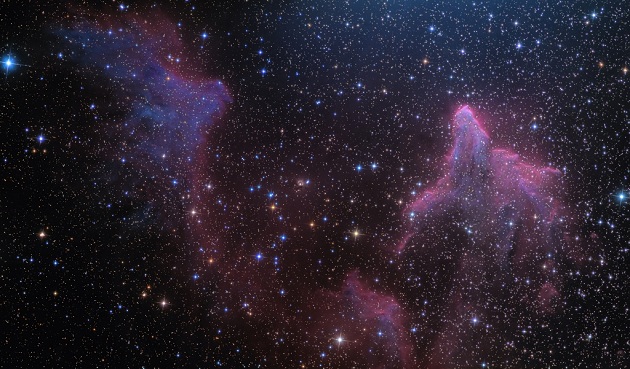By Annelies Rhemrev
November 15, 2012
IC 59 and IC 63, two arc-shaped nebulae in Cassiopeia
Image Credit & Copyright: Ken Crawford, Rancho Del Sol Observatory (http://www.imagingdeepsky.com)
Click here for a larger image.
IC 59 (left) and IC 63 (right) are a combination of faint, arc-shaped emission and reflection nebulae, located about 600 light-years away in the constellation Cassiopeia. Together they are approximately 10 light-years across.
The bluish glow shinning down from the top comes from the intense radiation of the bright, hot star Gamma Cassiopeia that is located only 3 to 4 light-years from the nebulae, and which may also have shed this nebulous material into the space around it. The edges of the nebulae glow brightly from this intense radiation that is slowly evaporating and lighting up these flowing shapes of gas and dust.
Gamma Cassiopeia is with a radius of 14 times our Sun, 55,000 times more luminous, 19 times more massive, and rotates at about 300 kilometers per hour, or 150 times more rapidly than the Sun. It is known as an eruptive blue-white subgiant variable star. (Eruptive variable stars vary in brightness because of violent processes and flares in their coronae and chromospheres.)
This star is an erratic variable that reached a maximum brightness in 1937, but then unexpectedly dropped in surface temperature from 12,000°K to 8500°K. It is encircled by a surrounding gaseous disk of material thrown off by its rapid rotation, that radiates the emissions. Mass loss is apparently related to the brightness variations.
IC 63 — the brighter of the two and slightly closer to Gamma Cassiopeia than IC 59 — is a combination of an emission and reflection nebula. Unlike a reflection nebula which appears blue, the glowing hydrogen gas appears red. IC 59 is primary a refection nebula, showing much less red hydrogen, and is appearing blue of dust reflected starlight that is passing through it.
See more images on Anne’s Astronomy News



